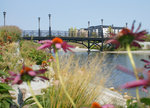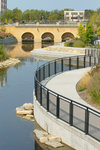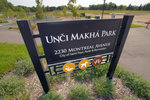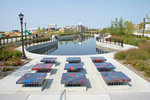




More than 10 years after Highland Park’s massive Ford assembly plant closed, a new planned community is taking shape on the former plant’s sprawling site overlooking the Mississippi River.
Highland Bridge, as the site is now known, is still mainly a busy construction zone. But the development is starting to take on the feel of an authentic St. Paul neighborhood now that a network of streets is in place linking Highland Bridge to the broader Highland Park community.
The project’s most distinctive feature is its waterway, a meandering stream landscaped with walkways and gardens, that runs through the center of the 122-acre development. The waterway is intended to replicate a natural stream that had been covered over when the Ford plant was built in the 1920s. While providing a prominent amenity for Highland Bridge, the waterway functions as a storm water management system, cleansing rain run-off and channeling it over Hidden Falls before the stream empties into the Mississippi. When the final stage of the waterway is completed, visitors will be able to walk along the stream through a tunnel under Mississippi River Boulevard to a newly-built Hidden Falls overlook.
The concept for the waterway, also known as the water feature, was incorporated in the city’s initial master plan for the Ford site. The plan proposed a highly dense residential and commercial development with some buildings as high as seven or eight stories. When it released the plan in 2017, the city of St. Paul ignited a fire storm of opposition from an angry group of Highland Park residents who were convinced that the project would overrun their neighborhood with traffic and congestion. Later, when the city selected the Ryan Company as the site’s master developer, the plan was modified by reducing the number of housing units in the project and limiting the height of the buildings to five stories.
Frank Jossi, a longtime Highland Park activist, thinks St. Paul made the right move by selecting the Twin Cities-based Ryan to develop the Ford site. “Ryan was a known quantity, a local developer who understood neighborhood dynamics. If the city had gone with an out-of-town firm, the project might never have happened,” he said.
Jossi remembers the night that Ryan unveiled its own plan at a community meeting at Highland Park High School “They had a video rending that made the project seem real. Until then, the plan had only been abstract-words and drawings on pieces of paper. Now, people could see the parks and open space and how they related to the buildings. When Ryan was finished with its presentation, people stood up and applauded. That was the turning point. After that night, the opposition became much more muted.”
In the months following the Highland High School meeting, as the Ryan plan was refined, the city officials worked with neighborhood resident to select names for the new city-managed parks at Highland Bridge. Two of the names selected reflected the history of the site. One park was named “Unci Makha” (Mother Earth in Dakota), which recognized the site’s native legacy. Another was called “Union Assembly,” which honored the men and women who worked at the Ford Plant.
A third green space, known as Gateway Park may not have had an historical reference, but that park, which included a skateboard installation, had special significance for two young Highland Park residents. Theo Miller was 10 years old and his buddy, Luke Hanno, was 12 when they persuaded the city council to include a skateboard park in Highland Bridge. Their lobbying efforts led to the creation of Gateway Park.
In addition to the park names, the project’s planners and designers found other subtle ways to include historical references in the new development. A circular grate guiding the waterway flow was intended to evoke the spokes on the wheels of Ford’s iconic Model T. Colorful coverings for a series of overflow drains were made of Fordite, a material extracted from the floors of the paint shops at Ford assembly plants.
One parcel of the property, included in the master plan but not controlled by Ryan, has sparked a recent controversy. St, Thomas University hopes to purchase the 13-acre parcel now mostly owned by the Canadian Pacific Railroad for use as athletic fields. Still in the discussion stage, the St. Thomas plan is getting push back from some nearby neighbors.
While the parks and open space at Highland Bridge are receiving widespread praise for their public accessibility, housing under construction on the site is much less accessible – at least in financial terms. One rental development, known at The Collection, which sits on top of the new Lunds & Byerlys grocery store, is completed and now being leased. Rents at the Collection start at about $1,450 a month for a 480-square studio apartment and top out at over $5,000 for the largest two-bedroom units.
Marvella, the senior housing project under development by Presbyterian Homes, offers independent living, assisted living and memory care. Monthly rents for Marvella’s smallest independent units start at about $2,280 with an upfront entry fee of just under $50,000. Marvella’s larger two-bedroom units have all been reserved. They rent for $4300 a month, with an entry fee of $185,000. For-sale town houses start at $800,000, while costs for the 35 single-family homes on the site are expected to exceed $1 million.
The master plan calls for 20% of the housing units at Highland Bridge to be affordable. If fully implemented, the 20% goal would provide 760 units targeted at people with incomes of up to 60% of the Twin Cities area median. Thus far, only about 195 units of affordable housing in three separate projects are on the drawing boards. Those projects are on hold, pending a revision of St. Paul’s rent control ordinance.
“The truth is that not many current Highland Park residents can afford to live in Highland Bridge,” Jossi acknowledged. “That is the reality of the housing market in 2022. But this new development does provide public amenities that are available to everyone in the community.
“I think the city and Ryan have done an exceptional job of creating a park system that meets the needs of a variety of groups. There is this beautiful water feature where people can sit and read a book or just enjoy the view There is a nature park that children and their parent can explore, a dog park for pet owners, volleyball courts and a skate board park for young people, picnic areas for families, even posts where visitors can hang hammocks.
“Even though Highland Bridge has only been open for a few weeks, people are already discovering everything the area has offer. On balance, I think Highland Bridge is a real plus for our community.”
Comments
No comments on this item Please log in to comment by clicking here